Plan checklist
Cailes
1480 County Road 3, Carrying Place, Lake Ontario
Planting plan created by Watersheds Canada
Schedule A:
Plants & Property
Land Characteristics
This planting plan is designed based on the land characteristics identified during the day of the site visit. Plants are chosen according to the soil and light conditions on your property. The number of plants chosen for each planting compartment takes into account the square metre area of the space, as well as the amount of current vegetation cover.
Land Characteristics by Compartment
| Length | Width | Area | pH | Soil | Moisture | Light | Height | |
|---|---|---|---|---|---|---|---|---|
| A | 7m | 2m | 14m2 | normal | loamy | normal, moist | full sun | any |
| B | 9m | 3m | 27m2 | normal | loamy, clay | normal, moist | full sun, partial sun | any |
| C | 8m | 2m | 16m2 | normal | sandy, loamy | normal, moist | full sun, partial sun | any |
| D | 10m | 2m | 20m2 | normal | sandy, loamy | normal, moist | full sun | any |
| 34m | 2.25m | 77m2 |
Plant Selection Summary
The following shrubs and trees are chosen for their suitability and survivability given the current soil and light conditions in each compartment on your property, as well as preferable features.
| Plant Species | A | B | C | D | Potted | Bareroot | Wildflower |
|---|---|---|---|---|---|---|---|
| Fragrant Sumac | 6 | 6 | 12 | ||||
| Narrow Leaved Meadowsweet | 10 | 10 | 20 | ||||
| Sweet Gale | 10 | 10 | 20 | ||||
| Black-Eyed Susan | 6 | 6 | 12 | ||||
| Lance-Leaf Coreopsis | 6 | 6 | 12 | ||||
| Virginia Creeper | 6 | 6 | 12 | ||||
| Swamp Rose | 10 | 10 | 20 | ||||
| Butterfly Milkweed | 6 | 6 | |||||
| Subtotal | 38 | 38 | 22 | 16 | 24 | 60 | 30 |
| Totals | 114 | ||||||
Plant Information
The following table summarizes key information about each plant selected for your property.
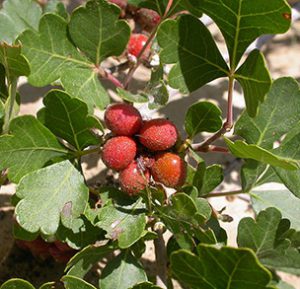
|
Fragrant SumacHeight: 1-2m
The Fragrant Sumac is a medium-sized deciduous shrub within the Cashew family. This species grows between 1-2 meters in height, is multi-stemmed, and produces a round, dense crown composed of erect and spreading branches. Between March and April, small yellow flower clusters bloom on the terminal ends of the branches prior to leaf development. Fruit development begins during late summer. Small, red, hairy berries are produced and can remain on the plant throughout the winter. Male catkins develop on the plant in September. Fragrant Sumac leaves are simple and arranged alternately along the branch. Leaves produced are simple and trifoliate with a large center lobe, appearing similar to Poison Ivy. During the spring and summer, the leaves are light green to green-yellow in colour turning a bright yellow to red or dark purple in autumn. Crushed leaves and stems of the Fragrant Sumac produce a fragrant citrus aroma, hence the common name. The aroma of this shrub is attractive to butterfly species, making it the perfect addition to any butterfly garden. The roots of the Fragrant Sumac are shallow, fibrous, and spread rapidly, making it an ideal choice for stabilizing shorelines and mitigating erosion on steep slopes. Unlike other Sumac species, Fragrant Sumac is significantly less aggressive and easily maintained.
|
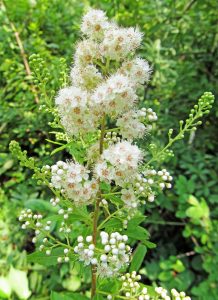
|
Narrow Leaved MeadowsweetHeight: 1-2m
The Narrow Leaved Meadowsweet is an erect, deciduous shrub, which grows in the shape of a mound to a height of 1-2m. This species develops numerous branches and branchlets, giving it a sparse appearance. Leaves produced are simple and narrow with sharply toothed borders growing alternately along the branches. These bright, light green leaves appear crowded, as they grow close together on the stocks and branches. During the fall, leaves turn a yellow-red or yellow-orange colour. Small white to light pink flower clusters appear in the spring growing in a dense, narrow pyramid at the terminal ends of the branches. During late summer to early fall, these flowers produce smooth, papery seed pods.
|
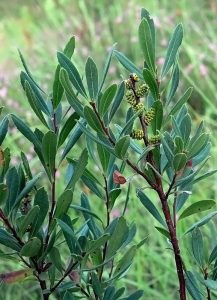
|
Sweet GaleHeight: 1-2m
Sweet Gale is a medium-sized shrub which grows into a thick bush about 1-2 m tall. This species produces 1-8 cm long, oblong-lanceolate leaves which are finely toothed at the tip and are spirally arranged. When bruised, these leaves give off a pleasant aroma. Male and female catkins are produced on separate plants. The seeds are dispersed from the female plants via water, as they float on two corky bracts. This shrub also provides a good food source for bird species that eat the seeds including Grouse, Chickadees, and Bluebirds. Mammal species like Beavers and White-Tailed Deer also browse on the twigs and leaves of this plant.
|
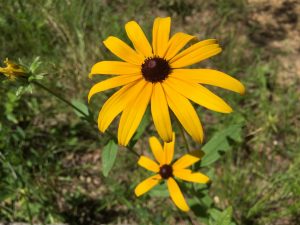
|
Black-Eyed SusanHeight: 1 m
Black-Eyed Susan is a popular biennial or a short-lived perennial wildflower species that typically grows about 1 m in height. Its leaves are green, alternately arranged, lance shaped, and covered with bristly hairs giving the leaf a grey/green colour. The flowers are daisy-like, have 8-20 yellow ray florets surrounding numerous dark brown disk florets, and blooms between June and September. The flowers are beneficial to pollinator species, like bees and butterflies. The seeds are also beneficial to wildlife species, like birds and small mammals. This flower blooms for long periods.
|
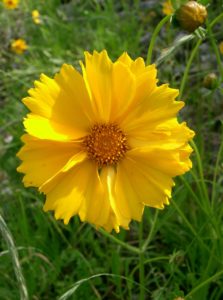
|
Lance-Leaf CoreopsisHeight: 45-90 cm
Lance-Leaf Coreopsis is a hardy, perennial wildflower species that grows between 45-90 cm tall. The leaves are mostly basal, medium green, narrow and lance shaped, slightly hairy, oppositely arranged, and have entire margins. The flowers are showy, bright yellow with a dark yellow center, daisy like, have 8 toothed rays, appear solitary at the tip of a flowering stem, and bloom between May and July. The flowers are beneficial to pollinator species, like bees and butterflies. The Lance-Leaf Coreopsis is hardy, easy to grow, and spreads quickly so can be valuable for re-vegetating disturbed sites.
|
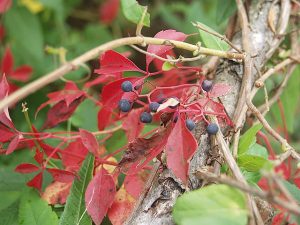
|
Virginia CreeperHeight: 15 m
The Virginia Creeper is a deciduous, woody vine species which can grow up to 15 m if near a tall structure or tree. The leaves are palmately compound with five ovate shaped leaflets. These leaves are largely toothed and turn bright red and orange during the fall. Despite having inconspicuous flowers, this species produces incredible dark blue berries, which are beneficial to birds and small mammals. This vine can grow 2-3 m per growing season, thus pruning and maintenance may be required. Virginia Creeper may sometimes be confused with Poison Ivy as younger plants will only have three leaflets instead of five. This plant can grow aggressively so should be planted where it has plenty of space to spread. Some shoreline landowners choose to plant this around rip rap/loose stone retaining walls for a more natural appearance. The root system is beneficial for quickly controlling erosion.
|
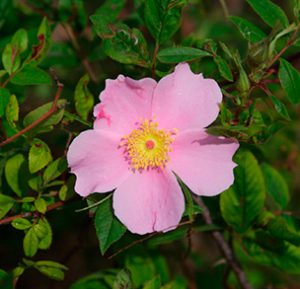
|
Swamp RoseHeight: 2m
The Swamp Rose is a beautiful perennial shrub species that typically grows 2m in height and spreads 2m. It is visually appealing with large pink flowers that last about 6-8 weeks. These flowers have five pink petals, a yellow center, and a pleasant fragrance. This species produces oblong shaped, compound leaves comprised of seven leaflets with serrated edges. The Swamp Rose produces red, round, fleshy fruit called rose hips, which remain on the bush throughout winter. These fruiting bodies provide a winter food source for wildlife, such as Grouse, Black Bears, Deer, and Rabbits. Swamp Rose may be confused with Prickly Wild Rose, which has a similar appearance. However, Swamp Rose can easily be distinguished by the presence of curved thorns, which appear at the nodes of the twigs without any occurring between the nodes. Swamp Rose grows best in moist, rich soils such as swamps and marshy shorelines. However, this species can also tolerate drier, loamy soils.
|
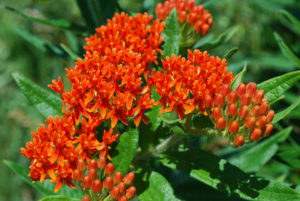
|
Butterfly MilkweedHeight: 0.5 m
Butterfly Milkweed is a very attractive perennial wildflower that typically grows about 0.5 m tall. This plant may also be known by the common name Showy Milkweed. The leaves are green coloured, alternately arranged, narrow and lance-shaped, and have entire margins. The flowers are showy, fragrant, bright orange coloured, have five tiny petals, appear in clusters of 8-25, and bloom between June and August. Butterfly Milkweed is easy to grow and is low maintenance. This wildflower spreads well and can be used to naturalize un-vegetated areas. The roots can be useful for controlling erosion and stabilizing shorelines. The flowers are beneficial to pollinator species, like bees and butterflies. It is also a larval host for caterpillars of the endangered Monarch Butterfly, thus planting this species where possible can help protect this at risk species.
|
Compartment A
Naturalization Area
 pH: normal
pH: normal Depth: potted, bareroot, wildflowers
Depth: potted, bareroot, wildflowers-
 Moisture: normal, moist
Moisture: normal, moist -
 Soil Type: loamy
Soil Type: loamy  Plant Height: any
Plant Height: any-
 Light conditions: full sun
Light conditions: full sun
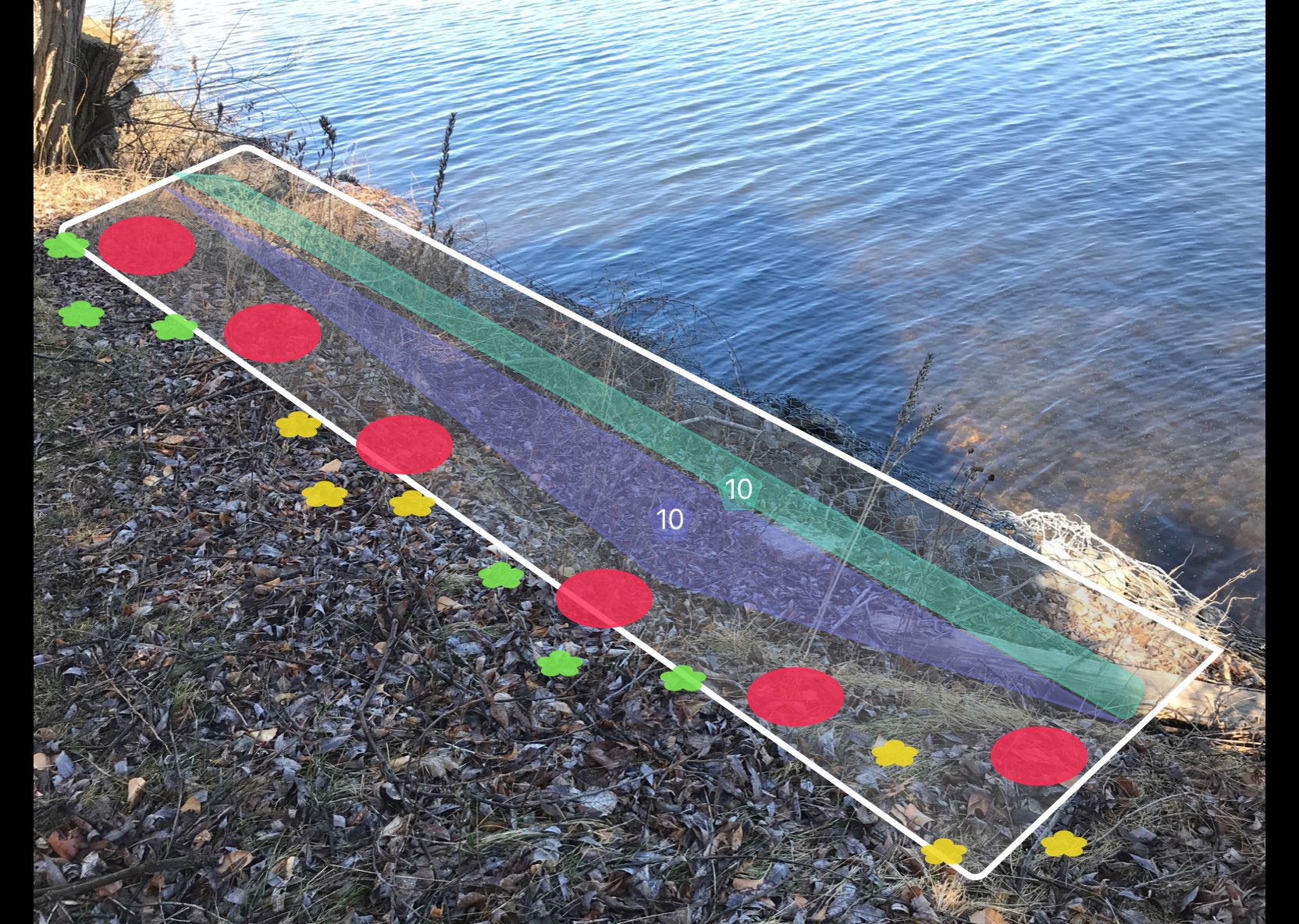
Compartment B
Naturalization Area
 pH: normal
pH: normal Depth: potted, bareroot, wildflowers
Depth: potted, bareroot, wildflowers-
 Moisture: normal, moist
Moisture: normal, moist -
 Soil Type: loamy, clay
Soil Type: loamy, clay  Plant Height: any
Plant Height: any-
 Light conditions: full sun, partial sun
Light conditions: full sun, partial sun
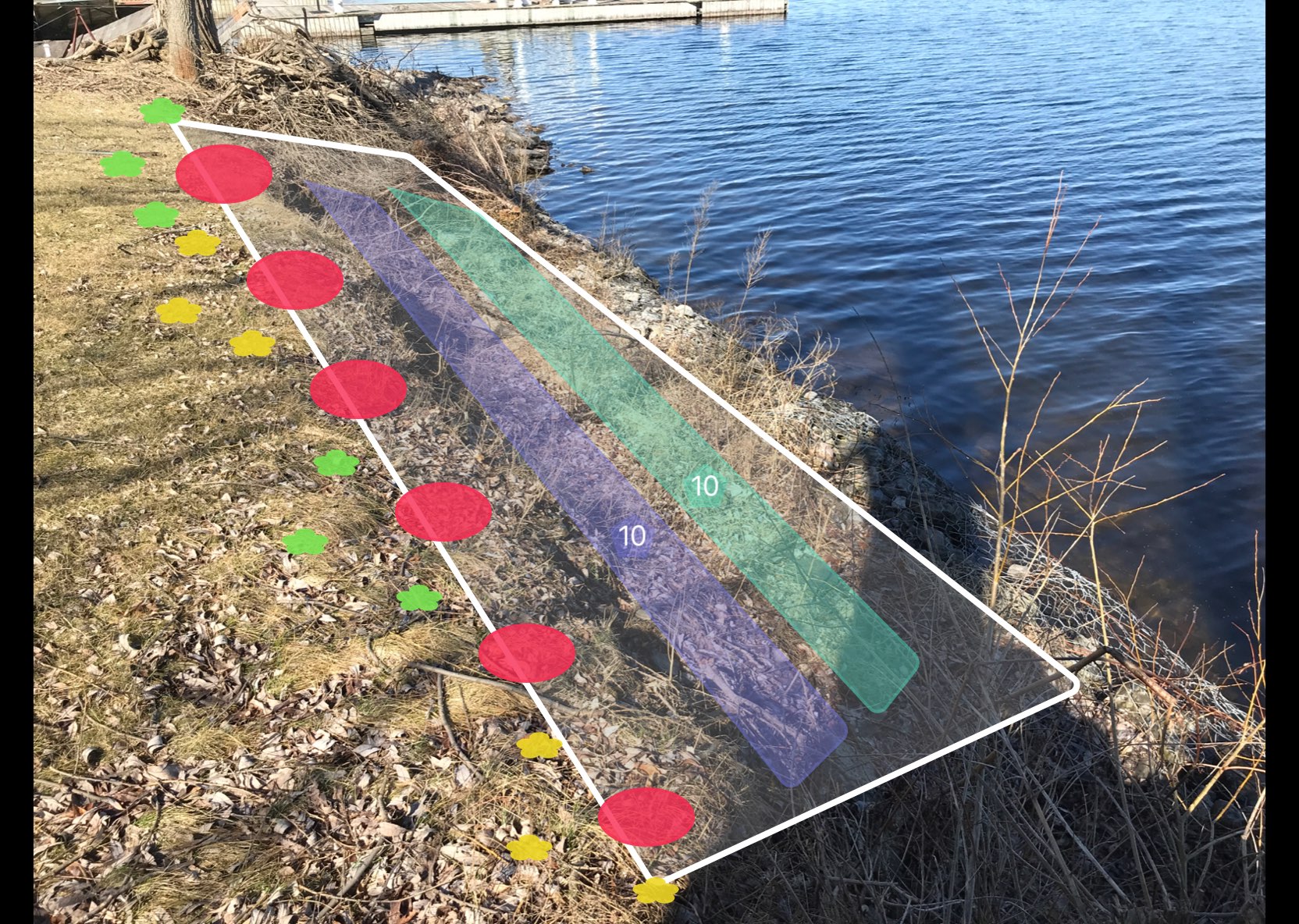
Compartment C
Naturalization Area
 pH: normal
pH: normal Depth: potted, bareroot, wildflowers
Depth: potted, bareroot, wildflowers-
 Moisture: normal, moist
Moisture: normal, moist -
 Soil Type: sandy, loamy
Soil Type: sandy, loamy  Plant Height: any
Plant Height: any-
 Light conditions: full sun, partial sun
Light conditions: full sun, partial sun

Compartment D
Naturalization Area
 pH: normal
pH: normal Depth: potted, bareroot, wildflowers
Depth: potted, bareroot, wildflowers-
 Moisture: normal, moist
Moisture: normal, moist -
 Soil Type: sandy, loamy
Soil Type: sandy, loamy  Plant Height: any
Plant Height: any-
 Light conditions: full sun
Light conditions: full sun
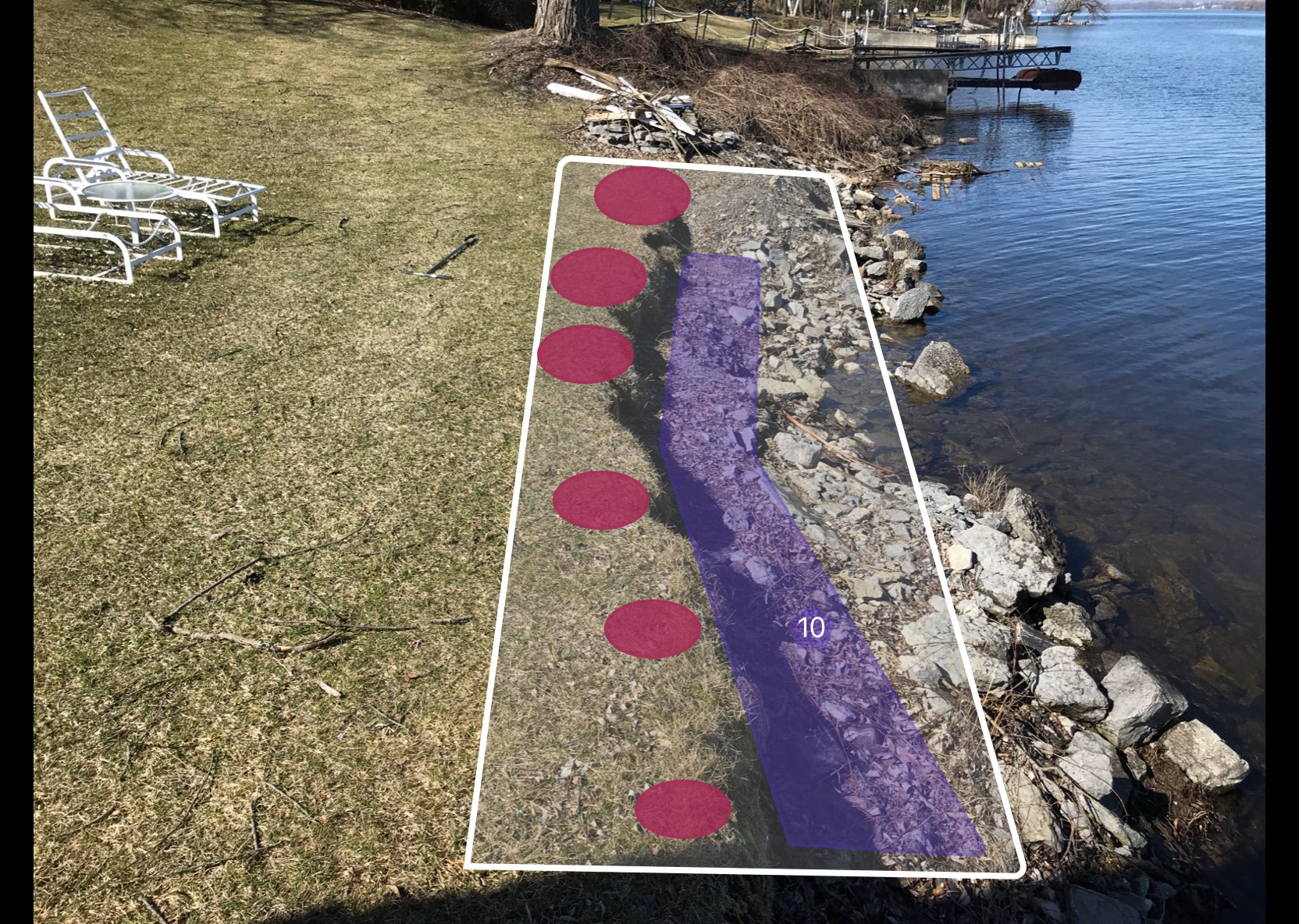
Schedule B
Financial Summary
Project by: Watersheds Canada
Shoreline Re-Naturalization Starter Kit includes: free site visit, customized re-naturalization planting plan for your shoreline property, native plants including free bare root (small) and potted (large) plants and wildflowers, coconut fibre pads to deter grass from growing around new plantings, tree guards for all deciduous trees, mulch for your wildflowers, Plant Care Guide with instructions on how to take care of your new plants, Habitat Creation Guide and a Wildflower Garden Guide.
Our planting plans are created onsite with you and provide detailed information and plans to re-naturalize your shoreline property. We take photos of areas for planting and overlay native plants that are well suited to your property based on site conditions such as soil type and sunlight availability.
We will work with you to create a plan that works for you including options for low growing plants in areas where views are important.
| Item | Quantity | Cost/Item | Subtotal |
|---|---|---|---|
| Starter Kit fee | $395 | ||
| Free potted plants | 15 | $0 | $0 |
| Paid potted plants | 9 | 13.00 | 117.00 |
| Free bareroot plants | 25 | $0 | $0 |
| Paid bareroot plants | 35 | 2.25 | 78.75 |
| Free wildflowers | 10 | $0 | $0 |
| Paid wildflowers | 20 | 6.00 | 120.00 |
| Total costs | 710.75 |
Schedule C
Project Agreement
Stewardship Agreement
Please indicate your agreement to this proposed plan by signing the following Stewardship Agreement and submitting it, along with your financial contribution, to:
Watersheds Canada
115-40 Sunset Blvd. Perth ON K7H 2Y4
Plant Availability
Please note that plant species may need to be changed based on plant stock availability at the time of ordering.
Project Completion
Upon receiving your signed stewardship agreement and financial contribution, a date will be booked for you to pick up your Natural Edge Kit. Watersheds Canada will supply all plants and materials. If you are paying for the planting to be completed for you, a date will be arranged for Watersheds Canada to plant your shoreline, bringing the plants and materials with them. If there are particular dates that you would prefer, we will do our best to accommodate your requests.
The Natural Edge Stewardship Agreement with Watersheds Canada
Agreement made this Day of the Month of in the Year .
BETWEEN Bianca Cailes 1480 County Road 3, Carrying Place Ontario (Hereinafter called the OWNERS)
AND Watersheds Canada 115-40 Sunset Blvd. Perth ON K7H 2Y4 (Hereinafter called WC)
WHEREAS the Owners and WC have met and discussed plans for shoreline naturalization on the specified area(s) in Schedule A existing on the Owners’ land;
WHEREAS the Owners indicate approval of the project as proposed; and
WHEREAS the project is, or will be for the benefit of the Owners and others;
NOW THEREFORE THE PARTIES AGREE AS FOLLOWS:
1. This Agreement shall be in effect for a period of 5 years, commencing with the date of this Agreement.
2. The Owners and WC agree that the areas where the work is to be performed is as described in Schedule A.
3. The Owners agree to pick up their Natural Edge Starter Kit from WC’s office and plant their shoreline within two days of receipt. The Owners will provide “after” photos of the work completed to be used for reporting purposes. If the Owners wish to have the planting completed for them, then WC or it’s contractors, employees and agents will complete the planting at cost, as indicated in Schedule B.
4. If the planting is to be completed by WC, then the Owners grant WC, its contractors, employees and agents, the right to enter the property to perform the work agreed upon as outlined in Schedule A. In addition, WC, its contractors, employees and agents may inspect the work performed for the purposes of monitoring the project and survival assessment, with prior agreement with Owners for date and time of inspection.
5. The Owners agree to contribute the “Landowner contribution” and pay the costs indicated in Schedule B.
6. In instances where the Owners are to pay WC for work to be performed (outlined in Schedule A), the Owners agree to provide payments to WC prior to the commencement of that operation. Failure of payment shall constitute a breach of this Agreement and the Owners agree that this Agreement will be terminated and thereupon the Owners agree to pay WC the estimated costs of the operations of the project completed to date, if any.
7. The Owners agree, if necessary, to perform a reasonable amount of maintenance, which is described in the Native Plant Care Guide, available at naturaledge.watersheds.ca.
8. If a contractor is required to perform the work outlined in Schedule A, then the contractor carrying out the work on the land described will be required to take out and furnish evidence of a comprehensive policy of public liability and property damage coverage. The contractor and their workers will be required to be in good standing with the Workplace Safety and Insurance Board (WSIB) prior to performing the work.
9. The Owners agree not to remove, destroy or alter the project without prior consultation and approval of WC. Pruning and trimming planted nursery stock, or adding replacement native nursery stock is exempt.
10. The Owners agree not to mow the planted area.
11. The Owners do acknowledge that WC, its contractors, employees and agents, having performed said works, are not under further obligation with respect to survival of nursery stock, inspection, or maintenance.
12. The Owners, in the absence of negligence, hereby remise, release and forever discharge WC, its contractors, employees and agents from all claims and demands for injuries, including death, loss, damages and costs in any way related to or connected with installation and maintenance of the work described or resulting from any deleterious effects of the work to the land or to the lands and buildings thereon retained by the Owners.
IN WITNESS WHEREOF the parties have agreed to the contents of this plan; SIGNED:
About this program
About Watersheds Canada
Watersheds Canada is a non-profit organization and registered Canadian charity committed to working with landowners, communities, and organizations to protect lakes and rivers through developing effective, transferable, and long-term solutions.
This program was created by Watersheds Canada
We believe that every person has the right to access clean and healthy lakes and rivers in Canada. At Watersheds Canada, we work to keep these precious places naturally clean and healthy for people and wildlife to continue using for years to come. We love working with others to meet the needs of local communities, whether you’re a concerned citizen, a landowner, a lake association looking for help, or a coalition of groups interested in activating your local community.

